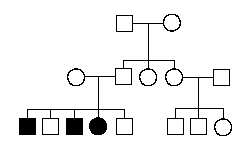Germline Mosaicism - Example
Pedigree

This pattern of inheritance is most often suspected if multiple children are affected by a disorder, and the parents and relatives are not affected. One parent must have had a mutation, but it was confined to the germ cells early in embryogenesis, so that somatic cells did not have the mutation, and the parent is phenotypically normal, but able to transmit the mutation to offspring. Some cases of achondroplasia, hemophilia A, and neurofibromatosis I, among others, may be transmitted in this fashion.
Neurofibromatosis type 1
NF1 is an autosomal dominant disorder. 50% of mutations are new. The NF1 gene contains approximately 250,000 base pairs (a high spontaneous number of mutations seen with this very large gene) and encodes a polypeptide of 2818 amino acids. The NF1 protein is found in many tissues and cell lines. The NF1 sequence has significant similarity to the catalytic domain of the GTPase-activating protein GAP. The NF1 protein is therefore thought to affect signal transduction by stimulating the conversion of the Ras protein from a GTP-bound active form to a GDP-bound inactive form. Ras function plays a key role in cellular growth and differentiation and altered NF1 control of ras may explain the neurofibromatosis phenotype. Persons with NF1 may have multiple nerve tumors (neurofibromas and neuilemmomas), pigmented skin macules (cafe' au lait spots), and pigmented nodules of the iris (Lish nodules). There is a risk for malignant neural tumors.
NF1 is a good example of a disease that can display pleiotropy (many different tissues and body parts affected) and variable expression (the severity of involvement can vary).


